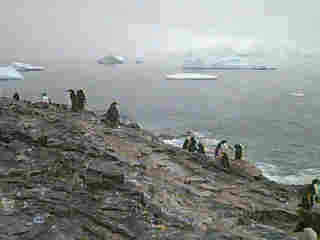
|
|
11 February, 1998
Gould-en Greetings!
Last night as the sky slowly dimmed, we slowly approached the first
beginnings of Tickle Passage. There were a few scattered icebergs, but
little sea ice. We entered and as the light grew less, the pack ice
increased. At first the captain sidestepped pieces of ice as if he were
avoiding the first blow. Then the ice was all the way across, and to
proceed, we had to meet it.
Cautiously, we waited for the sounds as we passed into the ice. Nothing.
A faint crunching, and then the ice passed by. We headed into areas that
seemed mostly white. The captain turned on his front light beams to help
him detect what was iceberg and what was sea ice. What is the difference
between the two? How could he tell one from the other? Three hours had
passed since many of science crew members had come up to the bridge to
watch the show of ship meeting ice. Every once in awhile, the Gould would
shudder a bit and we would hear some crunching as the ice, crushed and
broken, swept passed the ship's sides. I moved to the back area of the
bridge away from the lights and other people. This area afforded a good
side view. I had not been there long when I spotted 5 lonely penguins on a
large piece of ice. Frightened by the ship's proximity, they waddled off
the ice into the inky water. Several minutes later, I saw the fin of a
humpback whale as it proceeded in the opposite direction of our ship.
(Were the penguins in danger because of the humpback whale?)
Congratulating myself on the obviously animal-rich side of the boat, I
strained my eyes looking for more signs of life. There was no more to be
seen. I had seen it all I was to see in the space of 5 minutes. Ah, well,
Finally, the realization that morning and its duties would call entirely
too soon and most of us headed for bed. The ice noise was a bit greater in
the cabins than it had been in the bridge, but not so loud as to keep sleep
away. I was told by the ship's Second Mate who had watch at 4:00 AM that
the pack ice got thick enough at one point that they had to accelerate to
push the ship through some, but it really wasn't a problem. The Laurence
M. Gould has proven its worth in pack ice.
Today was light as far as science projects. A few CTD stations were
attended by water-collecting scientists, along with plankton nets and PRR.
But mostly, those who have taken data are entering it into a variety of
specially written computer programs for help in analysis.
On the bridge, Peter reported seeing a couple of Orcas and several humpback
whales. Tomorrow I hope to spend some time up on the bridge also. I have
yet to see an Orca in the wild. Wish me luck!
Warm regards,
Mrs. D

Contact the TEA in the field at
.
If you cannot connect through your browser, copy the
TEA's e-mail address in the "To:" line of
your favorite e-mail package.
|
